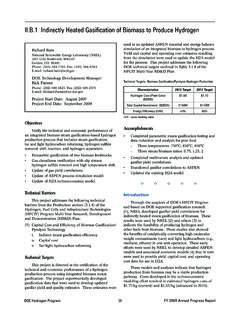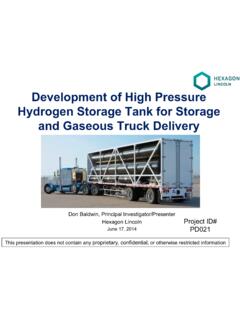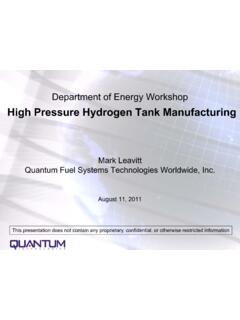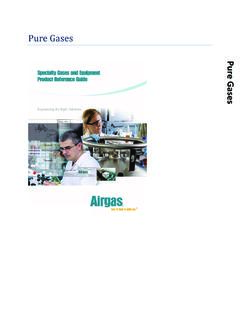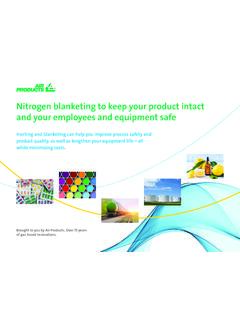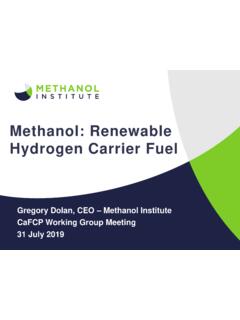Transcription of Hydrogen Storage Cost Analysis - Energy
1 Hydrogen Storage cost Analysis Cassidy Houchins (Primary Contact), Brian D. James, Jennie Huya-Kouadio, Daniel DeSantis Strategic Analysis , Inc. 4075 Wilson Blvd, Ste. 200 Arlington, VA 22203 Phone: 703-527-5410 Email: DOE Manager: Bahman Habibzadeh Phone: 202-287-1657 Email: Contract No: DE-EE0007601 Subcontractors: Argonne National Laboratory, Argonne, IL Pacific Northwest National Laboratory, Richland, WA Project Start Date: October 1, 2016 Project End Date: September 30, 2021 Overall Objectives Identify and/or update the configuration and performance of a variety of Hydrogen Storage systems for both vehicular and stationary applications.
2 Conduct rigorous cost estimates of multiple Hydrogen Storage systems to reflect optimized components for the specific application and manufacturing processes at various rates of production. Explore cost parameter sensitivity to gain understanding of system cost drivers and pathways to lowering system cost . INTRODUCTION Fiscal Year (FY) 2019 Objectives Analyze Storage system sizing requirements and system specifications for medium- and heavy-duty fuel cell electric vehicles. Update 700-bar Type 4 light-duty vehicle system costs. Technical Barriers This project addresses the following technical barriers from the Hydrogen Storage section of the Fuel Cell Technologies Office (FCTO) Multi-Year Research, Development, and Demonstration Plan1: (B) System cost (H) Balance of Plant Components (K) System Life-Cycle Assessments.
3 FY 2019 Accomplishments Completed a scoping Analysis of medium- and heavy-duty fuel cell electric truck requirements and a preliminary cost Analysis of 350-bar Type 3, 500-bar cryo-compressed, and 700-bar Type 4 Storage systems for multiple Storage system packaging strategies. Modeled high -volume carbon fiber prices and compared results with industry-provided T700S price quotes. Updated 700-bar Type 4 light-duty vehicle Storage system costs, including updates to carbon fiber prices and low-volume balance of plant component costs. FCTO has identified Hydrogen Storage as a key enabling technology for advancing Hydrogen and fuel cell technologies and has established goals of developing and demonstrating viable Hydrogen Storage technologies for transportation and stationary applications.
4 The cost assessment described in this report supports the overall FCTO goals by identifying the impact of components, performance levels, and manufacturing/assembly techniques on Storage system cost at a variety of annual manufacturing rates. The results of this Analysis enable DOE to compare the cost impact of advances in components, materials, and manufacturing to cost targets. Results from the detailed cost models reported under this project help guide future R&D decisions by providing insight into which components and cost have the greatest potential to reduce system cost . APPROACH A Design for Manufacture and Assembly style cost Analysis methodology was used to assess the materials and manufacturing cost of Hydrogen Storage systems and components. Key system design parameters and 1 FY 2019 Annual Progress Report 1 DOE Hydrogen and Fuel Cells Program Houchins Strategic Analysis , Inc.
5 Hydrogen Fuel R&D / Testing and Analysis engineering system diagrams describing system functionality and postulated manufacturing process flows were obtained from a combination of industry partners, Argonne National Laboratory (ANL), Pacific Northwest National Laboratory (PNNL), and internal Analysis . This data was used to develop a mechanical design of each component, including materials, dimensions, and physical construction. Based on this design, the manufacturing process train was modeled to project the cost to manufacture each part. cost was based on the capital cost of the manufacturing equipment, operating cost of the machinery, equipment tooling amortization, material costs, and financial assumptions. Once the cost model was complete for the system design, sensitivity data for the modeled technology was obtained by varying key parameters.
6 Results were shared with ANL, PNNL, and industry partners to obtain feedback and further refine the model. RESULTS Medium- and Heavy-Duty Vehicles Medium-duty vehicles (MDVs) and heavy-duty vehicles (HDVs) are an increasingly important market sector of fuel cell vehicles. According to the 2016 Vehicle Technologies Market Report [1], annual vehicle sales of these two broad classes of vehicles was expected to be around 400,000 vehicles in the with 97% being produced domestically. In general, the on-board Hydrogen Storage requirements are significantly higher for fuel cell MDVs and HDVs than for light-duty vehicle (LDV) applications to meet the range and vehicle power requirements dictated by the vehicle s vocation [2]. Drive cycle analyses of multiple vocations typical of MDVs ( , refuse trucks, package delivery vehicles, and buses) and HDVs ( , line-haul and tractor trailers) show that most vocations fall into two groups with respect to Hydrogen on-board Storage requirements.
7 One group has a range of 10 30 kg H2 centered around 20 kg H2 and covers the MDV vocations. The other group, covering the HDV vocations, spans a range from 60 100 kg H2. There are three typical locations for storing compressed gaseous fuels, particularly compressed natural gas, on-board MDVs and HDVs: behind the cab, on the frame, and on the roof. The choice of where to mount the tanks and how many will vary by system integrator and will depend on various considerations such as cost , available space, and range requirements. Table 1 compares several system configurations (size and number of tanks, composite mass, location, pressure, and state). Preliminary system costs reveal trends that are similar to our Analysis of fuel cell electric bus Storage options [3].
8 Cryo-compressed Storage appears to have the advantages of lower capital cost and higher gravimetric capacity; however, preliminary total cost of ownership Analysis suggests 700-bar and 500-bar cryo-compressed systems are less expensive than 350-bar compressed and are at parity with each other when refueling costs are included. Compared with LDV system costs, 700-bar Type 4 MDV and HDV systems are dominated by the composite cost at all volumes investigated (10,000 200,000 systems/year) because the composite mass of MDV and HDV tanks is in the range of 200 1,000 kg/system. FY 2019 Annual Progress Report 2 DOE Hydrogen and Fuel Cells Program Houchins Strategic Analysis , Inc.
9 Hydrogen Fuel R&D / Testing and Analysis Table 1. Summary of System Capacities and Carbon Fiber Requirements for MDV and HDV Storage Systems Location Number of Tanks Interior Tank Length (inches) Interior Tank Diameter (inches) Usable H2 (kg H2/tank) Composite Mass (kg carbon fiber/tank) 350-bar cH2 500-bar CcH2 700-bar cH2 350-bar cH2 500-bar CcH2 700-bar cH2 BTC 2 4 80 16 2 4 80 21 RM 4 80 16 4 96 16 4 97 12 FM 1 2 60 21 1 2 80 21 1 2 120 21 1 2 60 26 1 2 80 26 1 2 90 26 1 2 120 26 350-bar Type 3 compressed (350-bar cH2), 500-bar cryo-compressed (500-bar CcH2), and 700-bar Type 4 compressed (700-bar cH2) Hydrogen Storage systems are considered.
10 Storage system dimensions are taken from A-1 electric ( ). Three package options were considered: behind the cab (BTC), roof-mounted (RM), and frame-mounted (FM). The composite masses were calculated by ANL. Carbon Fiber Price Based on input from industry experts, the current 2019 market price for T700S carbon is about 9% lower compared to 2010. Based on discussions with carbon fiber purchasers, the intermediate modulus carbon fiber market follows Toray s pricing due to Toray s dominant market position. An implicit assumption of our modeled carbon fiber price is that a larger vehicle market will lead to a more competitive carbon fiber market, more efficient precursor processing plants, and larger, more efficient carbonization plants. For example, at an annual production rate of 100,000 fuel cell vehicles the current intermediate modulus carbon fiber would be doubled [4].






